TQ31E had no records when I started to look at the tetrads in TQ31 with a view to turn them all green (an aim achieved when at east 40 taxa had been recorded in each). But the tetrad was daunting: a built-up area with very few bits of habitat that might yield a good variety of taxa. Earlier this year I visited a garden backing on to the railway with permission from the owners who my husband knew because they had a bat roost. This was quite a promising start with several woodland and grassland taxa surviving, as well as a surprising amount of Conocephalum conicum at the entrance to a damp tunnel. I found Bryum radiculosum at the base of the front wall of the house. I then went on to the reclamation centre by the station and found Homalothecium sericeum and Hypnum lacunosum on a huge limestone boulder as well as common acrocarps in the rubbly car park. Altogether I recorded 20 taxa that day but did wonder about the species on the boulder – someone could buy it and take it away. I made a note to revisit some time.
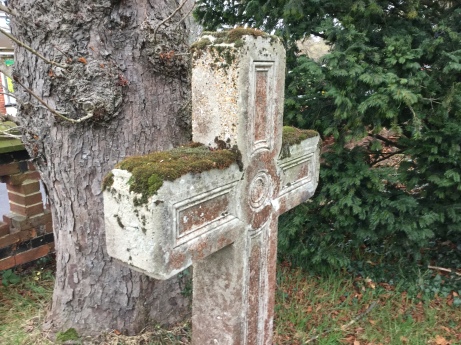
I resumed the exploration of the area recently by visiting brick-built St John’s church. Its walls hosted no bryophytes but the monuments and adjacent soil were more interesting, adding with Hypnum resupinatum, Didymodon rigidulus and D. sinuosus to the list among other common taxa. A weeping form of ash had large cushions of Orthotrichum affine and Cryphaea heteromalla but all the other trees were bryophyte-bare. The list was now up to 33.
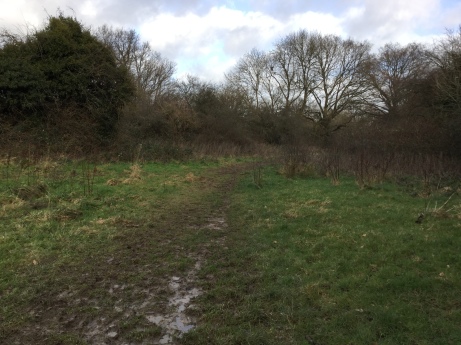
Dog-walking terrain between houses and the railway line.
It wasn’t until two days before Christmas that I had another opportunity to try to augment the list. A bit of grassland and woodland near Wivelsfield station bordered by houses and a railway line had somehow escaped development. I parked on a nearby road and found Syntrichia intermedia, Didymodon luridus and Bryum argenteum among another expected pavement species and fruiting Grimmia pulvinata and Tortula muralis on garden wall tops. The grassland was tussocky and not good moss habitat but I found a Bryum sp. that that I didn’t recognise on an adjacent railway bridge that was edged by vegetation and various assorted debris. At home, under the microscope I found it had numerous filamentous gemmae about 30 microns wide, which led me to believe it was Bryum moravicum. But it was not in typical habitat (trunks or branches of trees) and, never convinced of my tentative identifications of Bryum spp., I sent it to Tom who confirmed it and added his usual and valuable identification tips. The leaves are similar in outline to other members of the group that includes Bryum capillare but have a shorter apiculus. Another member of the group, Bryum donianum, also occasionally has gemmae but Tom checked that the specimen I sent had unistratose margins rather than the bistratose ones of B. donianum. In R. Braithwaite’s The British Moss Flora (1887) B. moravicum was listed as a Bryum capillare var. flaccidum recorded by Davies, among others, at Newtimber in Sussex.
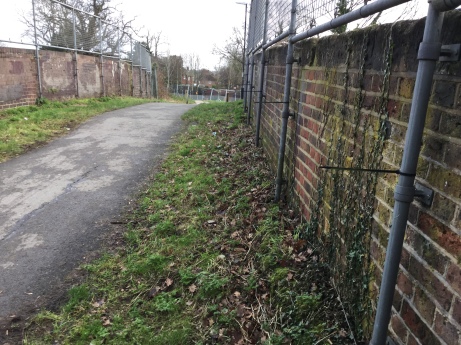
Bridge over the London to Brighton railway with Bryum moravicum on debris along the edge.
In the sparse woodland few trees bore epiphytes but branches of an old ash tree was had patches of Syntrichia papillosa, with the tips of the leaves bearing of shiny green gemmae balls, among more common taxa such as Orthotrichum affine and Hypnum spp. A hawthorn nearby had large patches of Cololejeunea minutussima.
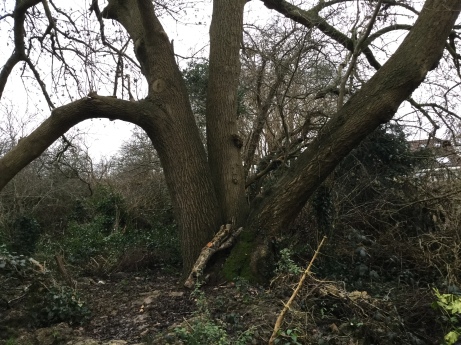
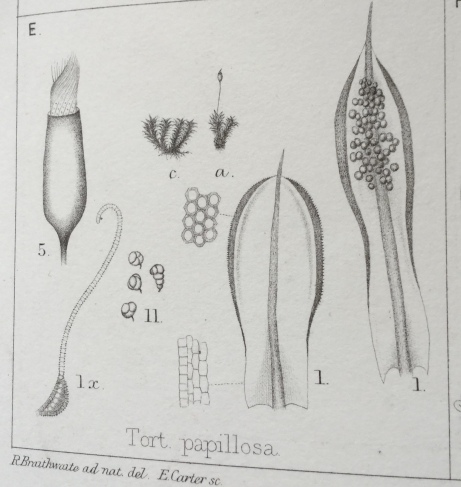
Syntrichia papillosa from R. Braithwaite’s The British Moss Flora (1887) recorded in Sussex at Hurstpierpoint by Mitten and Newtimber by Davies in 1857
So now the list for the tetrad stands at 43 taxa but I think that the Homalothecium sericeum and Hypnum lacunosum on the large chalk boulder should be removed from the records because when I checked on my way home the boulder had gone and is, presumably, now part of some other landscape.

Jacqui, you did very well to persevere and find various ways of attacking the problem that such a tetrad presents.
If you wanted to, you could salvage records like the one you found in Braithwaite. Newtimber Holt is quite likely to be the place that Davies saw Bryum moravicum and I even found it myself in the woods there. It would be quite acceptable to estimate a date range and then establish the most likely tetrad for the grid reference. It’s true there is a small chance he found it in an adjacent tetrad but it’s good to have these historical records and they don’t have to be completely accurate.
On the subject of introduced substrates, there is a system in place for recording them. Column N on the spreadsheet is labelled NS_ID. This can take a code number for different situations but it’s not necessary to use it except in such potentially misleading cases. The list is given below but in the instance you describe I would think it not really worth recording. Had the boulder been in someone’s rockery and looking well established then a code of 21 might have been suitable. I think this was the subject of a short article in Field Bryology in 2010 by Tom Blockeel.
NS_ID 1 NATIVE Native
NS_ID 2 INTRODUCTION Deliberate introduction
NS_ID 3 NATURALISED Naturalized escape or alien
NS_ID 4 MIGRANT Migrant
NS_ID 5 CASUAL Casual – present briefly (less than five years)
NS_ID 6 UNKNOWN Unknown
NS_ID 7 SURVIVING Surviving in wild for at least five years but not spreading
NS_ID 8 ESTABLISHED Established in wild for at least five years and spreading
NS_ID 9 NAT_EUROP Introduced and naturalised European species
NS_ID 10 NAT_NAM Introduced and naturalised North American species
NS_ID 11 STOCKED Population maintained or augmented by stocking
NS_ID 12 INDOORS Living indoors, e.g. in greenhouses
NS_ID 13 PLANTED Planted deliberately in a wild situation but not established
NS_ID 14 ALIEN Alien, but reported as native or without status by recorder
NS_ID 15 ALIEN EXC. CAS. Alien excluding casual
NS_ID 16 NAT_ASIAN Introduced and naturalised Asian species
NS_ID 17 INT_ASIAN Introduced Asian species
NS_ID 18 INT_EUROP Introduced European species
NS_ID 19 INT_AFRICAN Introduced African species
NS_ID 20 ALIEN_ALL Alien (all categories)
NS_ID 21 PERSIST Persisting only on substrate on which it was introduced
NS_ID 99 UNCERTAIN Status uncertain – presumed originally miscoded by recorder
LikeLiked by 1 person
Thank you Tom for that idea. I had already started listing bryophytes recorded in Sussex by Braithwaite so will get on with that job when it rains (again). I hadn’t been aware of the codes in Column N and their uses. I agree that the two species in question shouldn’t be recorded for the tetrad and will be aware of other possible instances in future where a code other than Native would be appropriate.
LikeLike
Pingback: Changing Places | Sussex Bryophytes